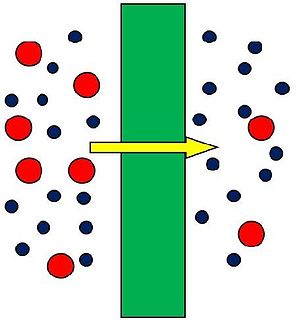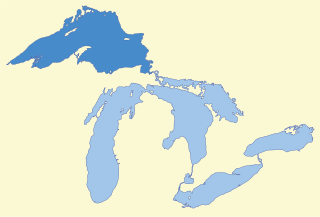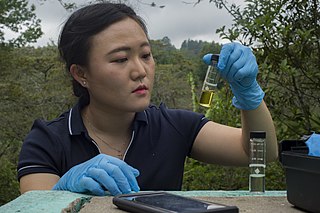
Water purification is the process of removing undesirable chemicals, biological contaminants, suspended solids, and gases from water. The goal is to produce water fit for specific purposes. Most water is purified and disinfected for human consumption, but water purification may also be carried out for a variety of other purposes, including medical, pharmacological, chemical, and industrial applications. The methods used include physical processes such as filtration, sedimentation, and distillation; biological processes such as slow sand filters or biologically active carbon; chemical processes such as flocculation and chlorination; and the use of electromagnetic radiation such as ultraviolet light.
Ultrafiltration (UF) is a variety of membrane filtration in which forces like pressure or concentration gradients lead to a separation through a semipermeable membrane. Suspended solids and solutes of high molecular weight are retained in the so-called retentate, while water and low molecular weight solutes pass through the membrane in the permeate (filtrate). This separation process is used in industry and research for purifying and concentrating macromolecular (103 - 106 Da) solutions, especially protein solutions.
Microfiltration is a type of physical filtration process where a contaminated fluid is passed through a special pore-sized membrane to separate microorganisms and suspended particles from process liquid. It is commonly used in conjunction with various other separation processes such as ultrafiltration and reverse osmosis to provide a product stream which is free of undesired contaminants.

Wastewater treatment is a process used to remove contaminants from wastewater or sewage and convert it into an effluent that can be returned to the water cycle with minimum impact on the environment, or directly reused. The latter is called water reclamation because treated wastewater can then be used for other purposes. The treatment process takes place in a wastewater treatment plant (WWTP), often referred to as a Water Resource Recovery Facility (WRRF) or a Sewage Treatment Plant (STP). Pollutants in municipal wastewater are removed or broken down.

Reclaimed or recycled water is the process of converting wastewater into water that can be reused for other purposes. Reuse may include irrigation of gardens and agricultural fields or replenishing surface water and groundwater. Reused water may also be directed toward fulfilling certain needs in residences, businesses, and industry, and could even be treated to reach drinking water standards. This last option is called either "direct potable reuse" or "indirect potable" reuse, depending on the approach used. Colloquially, the term "toilet to tap" also refers to potable reuse.

Toronto Water is a division of the City of Toronto that is responsible for the water supply network and wastewater management in Toronto, Ontario, Canada. It was created following the amalgamation of Metropolitan Toronto in 1998.
Nanofiltration (NF) is a relatively recent membrane filtration process used most often with low total dissolved solids water such as surface water and fresh groundwater, with the purpose of softening and removal of disinfection by-product precursors such as natural organic matter and synthetic organic matter.
The Thames Water Desalination Plant or Beckton Desalination Plant is a water desalination plant in Beckton, London, United Kingdom. The first of its kind in the UK, it was constructed for Thames Water by a consortium of Interserve, Atkins Water and Acciona Agua. The plant was officially opened by Prince Philip, Duke of Edinburgh on 2 June 2010. The plant can provide up to 150 million litres of drinking water each day – enough for nearly one million people.

Current River is a neighbourhood located north east of Port Arthur in the city of Thunder Bay, Ontario. It is separated from the main urban area of Thunder Bay by the Current River Greenway, a large parkland along the river after which the neighbourhood was named. It is home to approximately 4,780 people and has an ageing and declining population.
Membrane bioreactor (MBR) is the combination of a membrane process like microfiltration or ultrafiltration with a biological wastewater treatment process, the activated sludge process. It is now widely used for municipal and industrial wastewater treatment.
Reverse osmosis (RO) is a water purification process that uses a partially permeable membrane to remove ions, unwanted molecules and larger particles from drinking water. In reverse osmosis, an applied pressure is used to overcome osmotic pressure, a colligative property, that is driven by chemical potential differences of the solvent, a thermodynamic parameter. Reverse osmosis can remove many types of dissolved and suspended chemical species as well as biological ones (principally bacteria) from water, and is used in both industrial processes and the production of potable water. The result is that the solute is retained on the pressurized side of the membrane and the pure solvent is allowed to pass to the other side. To be "selective", this membrane should not allow large molecules or ions through the pores (holes), but should allow smaller components of the solution (such as solvent molecules, i.e., water, H2O) to pass freely.

A membrane is a selective barrier; it allows some things to pass through but stops others. Such things may be molecules, ions, or other small particles. Biological membranes include cell membranes ; nuclear membranes, which cover a cell nucleus; and tissue membranes, such as mucosae and serosae. Synthetic membranes are made by humans for use in laboratories and industry.

Degrémont is a company specializing in the production of drinking water, and in the treatment of sewage and sludge. After starting as a family business in France in 1939, it has since become a subsidiary of Suez Environment, employing 4,600 people in 70 countries, and generating annual revenues of €1.520 billion.
Raw water is water found in the environment that has not been treated and does not have any of its minerals, ions, particles, bacteria, or parasites removed. Raw water includes rainwater, ground water, water from infiltration wells, and water from bodies like lakes and rivers.

The Minjur Desalination Plant is a reverse osmosis, water desalination plant at Kattupalli village, a northern suburb of Chennai, India, on the coast of the Bay of Bengal that supplies water to the city of Chennai. Built on a 60-acre site, it is the largest desalination plant in India. Construction works were carried out by the Indian company IVRCL and the Spanish company Abengoa, under the direction of the Project Manager Fernando Portillo Vallés and the Construction Manager Juan Ignacio Jiménez-Velasco, who returned to Europe after the inauguration of the plant to work on Renewable Energy Projects. Originally scheduled to be operational by January 2009, the work on the plant was delayed due to Cyclone Nisha in October 2008, which damaged a portion of the completed marine works and destroyed the cofferdam meant for the installation of transition pipes. The trial runs were completed in June 2010 and the plant was opened in July 2010. Water from the plant will be utilised chiefly for industrial purposes such as the Ennore Port and North Chennai Thermal Power Station. However, during droughts, water from the plant will be supplied to the public, serving an estimated population of 1,000,000.
The Pittsburgh Water and Sewer Authority (PWSA) is a municipal authority in Pittsburgh, Pennsylvania. It is responsible for water treatment and delivery systems in the city of Pittsburgh, as well as the city's sewer system. In a 2010 report, the authority reported 80,557 drinking water service connections and 107,151 sewage connections. The authority claims to serve approximately 250,000 customers, though it does not report how this number is calculated.
Membrane technology covers all engineering approaches for the transport of substances between two fractions with the help of permeable membranes. In general, mechanical separation processes for separating gaseous or liquid streams use membrane technology.
The Altona Treatment Plant of City West Water is a small sewage treatment plant in Altona, Victoria, approximately 16 km west of Melbourne. Located on Queen Street between Laverton Creek and Altona Meadows, it services over 20,000 residential and business properties in the Altona, Altona Meadows, Laverton and Point Cook areas and treats close to 13 million litres of sewage a day.

The Nemmeli Desalination Plant is a water desalination plant at Nemmeli, Chennai, on the coast of the Bay of Bengal that supplies water to the city of Chennai. It is located about 35 km south of the city centre, along the East Coast Road. Built at a cost of ₹ 5,333.8 million, the plant is the second desalination plant in the city after the 100-MLD plant at Minjur and itself has a capacity to treat 100 million litres of seawater a day.












